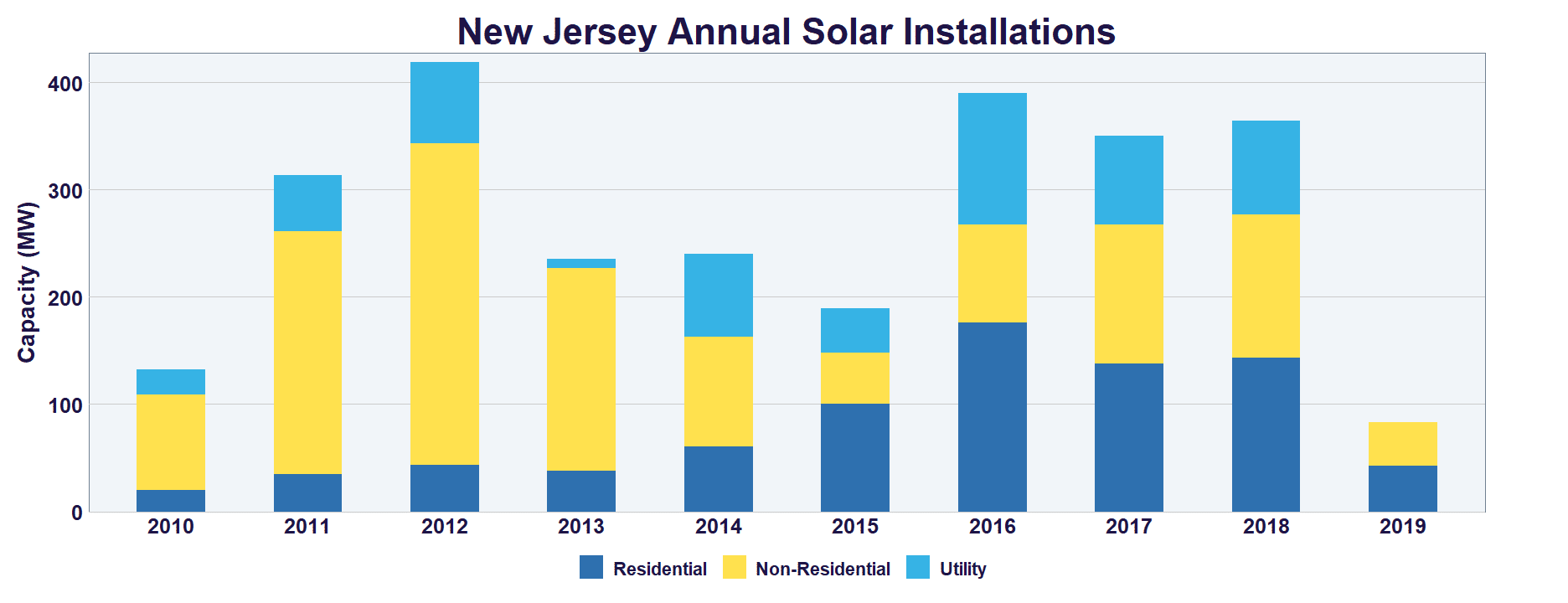The state of New Jersey is expected to soon finalize its 2019 Energy Master Plan, which sets a path to achieving 100% clean energy by 2050. Noting this, Gridworks, GridLab and the Center for Renewables Integration got together and authored The Role of Distributed Energy Resources in New Jersey’s Clean Energy Transition.
The paper outlines the capabilities of distributed energy resources (DER) and connects those capabilities to potential services DER may provide, whether those services be to individuals, a utility or the grid en masse.
New Jersey is an especially interesting case for this paper, due to its role in the relatively brief national history of the solar industry. New Jersey was, for a while, the second largest solar market in the United States, before it ceded its seat to North Carolina. Additionally, as the most densely populated state in the Union, the vast majority of New Jersey’s solar development to date has come from the residential and C&I sectors.

Image: SEIA
As reflected, the only year where utility-scale development rivaled either of the other sectors was 2016. It’s not like this is totally surprising, as a densely populated state presents itself naturally to rooftop solar: there’s a lot of roofs.
The big takeaway from the paper are the four key recommendations on how to best and most effectively reach that 100% by 2050 goal with a focus on DER. They are as follows:
- Integrate DER
- Embrace electrification of buildings and transportation
- Ensure an equity lens in planning
- Holistic grid planning
The first one there is pretty self explanatory: can’t have a role for DER if nobody is willing to embrace it. This, however, is easier said than done, and the authors place the onus of responsibility for this task on the shoulders of New Jersey regulators. This is because of a tune often sung in this publication: utilities hate DER, which threatens their investments in transmission and other infrastructure. However, if the issue of integration is led by the regulators, utilities can be forced to reach mandated DER levels within their generation portfolios.
Electrification of buildings and transportation is another relatively simple conclusion. Electric transportation and heating remove fossil fuels and in the case of transportation dramatically reduce energy use.
The goal of the equity lens in planning is twofold. Firstly, solar adoption has long passed over minority communities, especially low-income minority communities. Additionally, the paper cites the disproportionate siting of energy infrastructure in low income communities and communities of color, which means that these communities are the most immediate and harshly affected by the pollution spread from non-renewable generation. The paper outlines expansion of New Jersey’s community solar pilot program as an end to achieving increased access of solar to low-income and minority communities. In addition, this will increase the share of incentives reaching lower income individuals.
The final takeaway is the most vague of the bunch, purposefully so. The paper outlines this generally, reflecting that: “Holistic Grid Planning includes transparency in assessing the needs and capabilities of New Jersey’s distribution system, a threshold step to realizing the full value of DER.” The brunt of this responsibility is to be shouldered by the New Jersey Board of Public Utilities.
A dream of distributed power is alive in New Jersey, and if any level of this report is implemented, could be more a reality than dream. However, anything can look nice in a report, it’s the action that matters.
This content is protected by copyright and may not be reused. If you want to cooperate with us and would like to reuse some of our content, please contact: editors@pv-magazine.com.









By submitting this form you agree to pv magazine using your data for the purposes of publishing your comment.
Your personal data will only be disclosed or otherwise transmitted to third parties for the purposes of spam filtering or if this is necessary for technical maintenance of the website. Any other transfer to third parties will not take place unless this is justified on the basis of applicable data protection regulations or if pv magazine is legally obliged to do so.
You may revoke this consent at any time with effect for the future, in which case your personal data will be deleted immediately. Otherwise, your data will be deleted if pv magazine has processed your request or the purpose of data storage is fulfilled.
Further information on data privacy can be found in our Data Protection Policy.